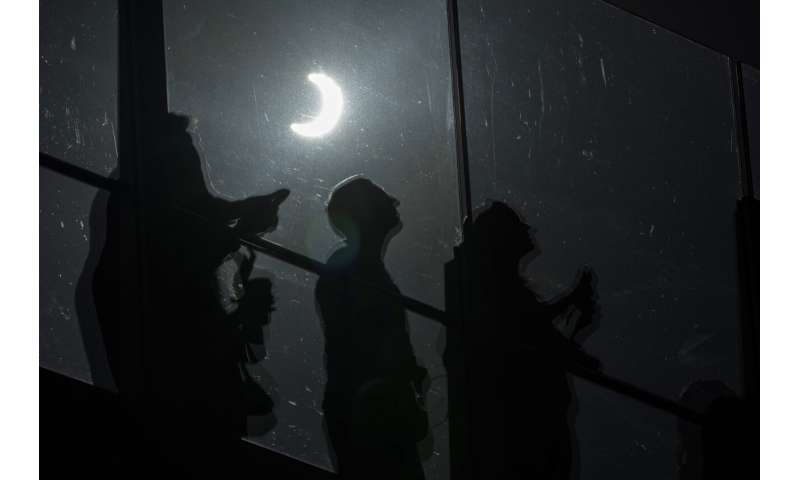

The moon, asteroids and brand new rockets topped the world’s space news in 2023.
Elon Musk’s monster rocket made it to space on the second test flight before exploding again. India landed successfully on the moon, outdoing Russia, which crashed. And NASA brought back its first samples of an asteroid.
These are just a few of 2023’s cosmic hits and misses. And there’s more to come in 2024.
MOON MANIA
The moon was the hottest ticket in town, with landing attempts in 2023 by Russia, India and a private Japanese company. Only India prevailed, becoming the fourth country to do so. Two U.S. companies, China and the Japanese Space Agency are targeting touchdowns, some as early as January. NASA kicked off 2023 by introducing the four astronauts who are slated to fly around the moon in late 2024—three from the U.S. and a Canadian. Another crew will actually land, but the timing is uncertain.
ROCKET DEBUTS
The biggest and most powerful rocket ever built, SpaceX’s Starship, launched twice from South Texas in 2023 and, both times, blew up and littered the Gulf of Mexico. The second test flight lasted twice as long and soared 93 miles (150 kilometers). SpaceX wants the empty spacecraft to make it around the world, before adding satellites and people. NASA’s next moonwalkers will need Starship to get to the lunar surface. Three other rockets are set to make their debut in 2024: United Launch Alliance’s Vulcan with a lunar lander, Blue Origin’s New Glenn, the company’s first orbital-class rocket, and Europe’s upgraded Ariane 6 rocket.

ASTEROID AUTUMN
NASA billed it as asteroid autumn. In September, the Osiris-Rex spacecraft delivered a batch of rubble collected from asteroid Bennu. A couple weeks later, the Psyche spacecraft blasted off on a six-year cruise to a metal-rich asteroid bearing the same name. Then in November, the Lucy spacecraft zoomed past the first asteroid on its crowded itinerary, discovering a mini moon with two fused orbs. Lab workers in Houston are still trying to pry open the asteroid sample canister that landed in the Utah desert. So far, scientists have removed 2.5 ounces (70 grams) of Bennu’s black dust and chips of rock.
SPACE TOURISM
Richard Branson’s Virgin Galactic started taking tourists on short rides to space in 2023 and whipped through five customer launches in less than five months from New Mexico. Only a few more are planned before the company stands down in mid-2024 to develop a rocketship that can fly more people more often. Musk’s SpaceX did its second private trip to the International Space Station and has more chartered flights coming up, as well as the first private spacewalk. Jeff Bezos’ Blue Origin hasn’t launched passengers since its New Shepard rocket carrying experiments crashed in Texas in 2022.
-

This image provided by NASA in July 2023 shows the Rho Ophiuchi cloud complex, the closest star-forming region to Earth, captured by the James Webb Space Telescope. (NASA, ESA, CSA, STScI, Klaus Pontoppidan (STScI) Image Processing Alyssa Pagan (STScI) via AP)
-

This photo provided by SpaceX shows the company’s Starship lifting off from Boca Chica, Texas on Apr 20, 2023. The biggest and most powerful rocket ever built launched twice from South Texas in 2023 and, both times, blew up and littered the Gulf of Mexico. Credit: SpaceX via AP
-

In this photo provided by NASA, Mari Montoya, left, and Curtis Calva use tools to collect asteroid particles from the base of a canister on Sept. 27, 2023, at Johnson Space Center in Houston. The Osiris-Rex spacecraft delivered a batch of rubble collected from the asteroid Bennu. Credit: NASA via AP, File
-

The moon passes between Earth and the sun during a rare “ring of fire” eclipse seen from Bryce Canyon National Park, Utah on Saturday, Oct. 14, 2023. Credit: AP Photo/Rick Bowmer, File
-

Guests watch a live broadcast from inside Virgin Galactic’s rocket-powered plane Unity 22, showing space tourists Anastatia Mayers, 18, and her mother Keisha Schahaff, rear, at Spaceport America, near Truth or Consequences, N.M., Thursday, Aug. 10, 2023. Virgin Galactic is taking its first space tourists on a long-delayed rocket ship ride. Credit: AP Photo/Andrés Leighton, File
-

People watch a rare “ring of fire” solar eclipse along the Las Vegas Strip, Saturday, Oct. 14, 2023, in Las Vegas. Credit: AP Photo/John Locher, File
CELESTIAL CLOSE-UPS
The James Webb Space Telescope marked its first year of cosmic picture-taking with the release of a wondrous shot of the closest star-forming region to Earth. It followed with a fresh look at the Crab Nebula, a supernova remnant previously photographed by the Hubble Space Telescope, and helped discover the oldest black hole yet, a goliath formed 470 million years after the Big Bang. “The James Webb continues to just do extraordinary things for us,” said NASA chief Bill Nelson. Hubble keeps churning out its own glamour shots, 30 years after spacewalking astronauts restored its vision in one of the most thrilling shuttle missions ever.
SOLAR ECLIPSES
The Americas reveled in a “ring of fire” eclipse in October, an appetizer to the total solar eclipse coming up in April. The sun, moon and Earth lined up to create the “ring of fire” solar eclipse from Oregon to Texas and parts of Central and South America. The moon was too far from Earth to completely blot out the sun, but will be at just the right distance on April 8. The total solar eclipse will begin in Mexico and head northeast through Texas and Arkansas, the Midwest, upstate New York, New England and Canada.
© 2023 The Associated Press. All rights reserved. This material may not be published, broadcast, rewritten or redistributed without permission.
Citation:
Images: Moon, asteroids and new rockets topped the world’s space news in 2023 (2023, December 12)
retrieved 12 December 2023
from https://phys.org/news/2023-12-images-moon-asteroids-rockets-topped.html
This document is subject to copyright. Apart from any fair dealing for the purpose of private study or research, no
part may be reproduced without the written permission. The content is provided for information purposes only.





